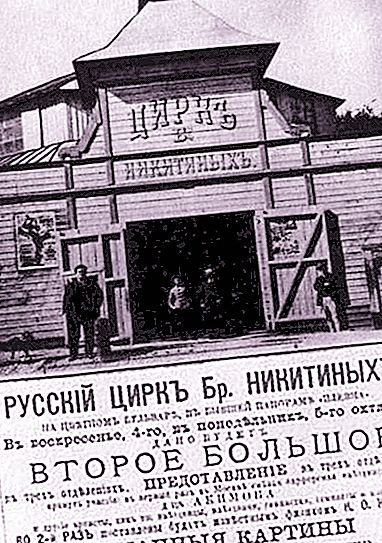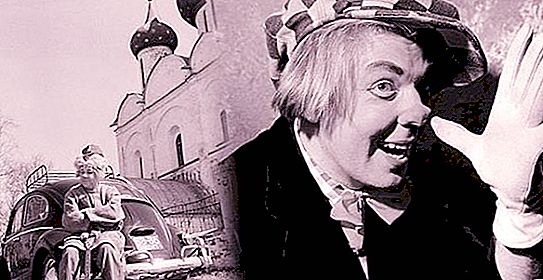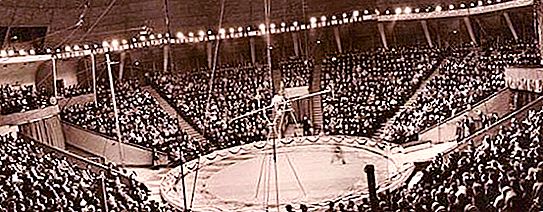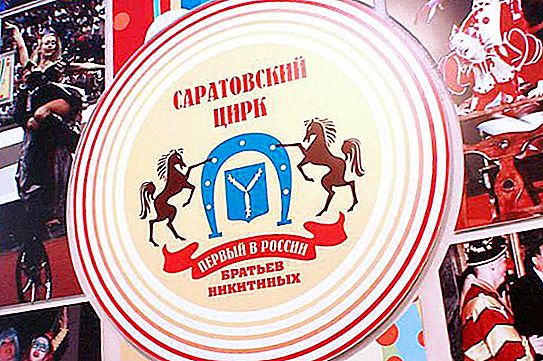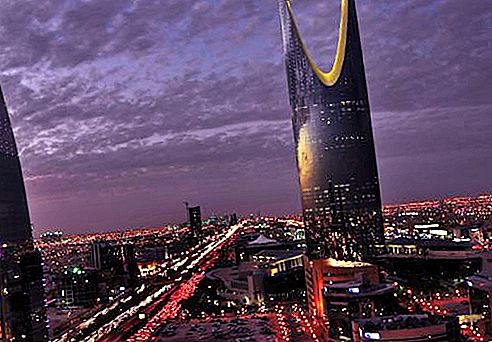The circus lives on legends and traditions. The invisible spirit of the great artists who once performed in the arenas of old circuses, as if concentrates under a dome and supports modern circus youth. And for the audience, this imperceptible image creates the illusion of celebration and mystery, which envelops everyone who crossed the threshold of the front door. You fully feel this when you visit the Saratov Circus. Nikitin brothers - one of the oldest stationary circuses in Russia.
The history of the Nikitin brothers circus
Legends begin with everyday, everyday events. How else to consider the return in 1873 to the homeland, to Saratov, of the brothers Peter, Akim and Dmitry Nikitin - artists and aspiring circus entrepreneurs. The appearance in the city of brothers immediately took advantage of the owner of the circus booth touring in Saratov, Emmanuel Baranek. Standing on the brink of ruin, he suggested that Nikitins become partners and co-owners of the enterprise. This was a reasonable step - the brothers were universal artists. Dmitry was famous as a virtuoso balalaika player and athlete, Akim was a red-haired clown, a cliche (an artist demonstrating flexibility of the body) and a juggler, and Peter owned the antipode (juggling legs), gymnastics, acrobatics and surprised the audience with swallowing. In the same year, the brothers bought circus property belonging to him from Baranek, and in 1876 a stationary wooden building was erected on Mitrofanyevskaya Square. Since that time, the Saratov circus has its chronology.
There was an interesting fact. The Nikitin brothers did not stop at the base of one circus. They built buildings in Nizhny Novgorod, Kharkov, Tiflis, Odessa, Baku. The circus empire of the brothers was crowned by a circus in Moscow (1912) at Sadovo-Triumfalnaya (now Satire Theater). A project of a stone building with an amphitheater for 2 thousand seats was prepared for Saratov, but the outbreak of the war destroyed the Nikitins' grandiose plans.
The fate of the circus after the revolution
The October Revolution changed life in the country and rebuilt the circus business. Nationalization passed, and the Saratov circus entered the structure of the city Art Trust, and later the All-Union Directorate of State Circuses. In 1931, the circus changed its address; a new stone building was built on Chapaeva Street. It did not shine with decoration, but it was convenient, and the auditorium contained 3 thousand seats. The audience loved the new building: in the first 5 years of the show, more than 2 million people attended. According to public reviews, one can evaluate the level of circus programs that came to Saratov - Vitaliy Lazarenko, Vladimir Durov, Emil Kio, Boris Eder. Already at the dawn of existence, the circus began staging work. Viewers saw the pantomime “Getting ready for battle” (1931-1932, staged by Volsky), “Moscow is on fire” (1932-1933, staged by Alperov on Mayakovsky’s poems) and other circus performances.
During the Great Patriotic War, the Saratov circus, the poster of which did not disappear from the city streets for a single day, continued to work and received artists evacuated from territories captured by the Nazis.
In the postwar period, the circus went through several reconstructions. In 1959-1963 made a phased change in the auditorium and the dome. At the same time, the artists continued to tour, and work was carried out in the offseason. In 1968, the Arena Hotel was commissioned. The circus was repeatedly celebrated among the best, and by the 100th anniversary it was awarded the Order of the Red Banner of Labor.
The second reconstruction of the building was dedicated to the 125th anniversary of the founding (1998). The name of the Nikitin brothers was officially fixed on circus posters - thanks to the founders from the artists of the new generation.
In the early days of the war, fundraising for the purchase of the Soviet Circus aircraft for the front began. In Saratov, artists for this collected almost 500 thousand rubles. In the spring of 1942, they received a telegram from the Supreme Commander-in-Chief I.V. Stalin in the circus with gratitude for this act.
Circus legends of Saratov
The circus is an amazing place. Not because people in it walk on their hands or put their heads in the jaws of a lion and do it daily and without visible tension or fear. It is striking in its democracy. Stars of the first magnitude, conquering the capital’s arenas and winning prizes at prestigious international festivals, receive a ticket to life in provincial arenas. The Saratov Circus is no exception to this rule.
In 1951, to participate in the next program in the city came a young artist, a balancer on free wire, a recent graduate of the circus school. The premiere took place, but the young man did not participate in it because of the delay in the delivery of props. But the misfortune happened at the performance - the carpet clown broke two ribs and ended up in the hospital. Circus artists are universal, they own many genres and are able to replace each other if necessary. The faithful should be replaced, and the choice fell on the beginner. He, of course, had no experience, no repertoire. Several rehearsals, someone else's costume, an unfamiliar props - and now the young artist in the arena makes his debut in a new role. But the audience does not accept the newcomer - he is trying to imitate the injured clown, and he doesn’t do it well, in the audience there is a liquid, “polite” applause. Number by number flew the first compartment and failure seemed inevitable.
It is difficult to say that during the intermission he brought the debutant to the kitchen of the circus canteen. Here he borrowed a cook hat and an apron, took several pots and pans, and put a couple of potatoes and carrots in his pockets. The second part began and the artist decided to shorten the path, to get to the arena with intricate service corridors. I ran to the sounds of music, opened all the doors and ended up in an orchestra box! Astonished musicians examined the origin of the cook, and in the arena the first number was already ending. Directly through the orchestra, the beginner went to the audience.
Surprised by the unexpected transformation of the clown and his unconventional appearance, the inspector of the arena (program leader) on the move oriented and played along. And now the audience is looking at the clown with interest (they did not recognize him in a cook suit), and he fervently juggles carrots and potatoes, balancing pans. All this improvisation was accompanied by youthful enthusiasm and genuine courage. The audience was conquered, the debutant earned a storm of applause. Another 20 days, the young artist replaced the carpet clown. He rehearsed reprisals, made props, and jokes became sharper and funnier. The young man from Saratov went to Riga already in the role of a clown, whom he has not changed until today.
Then there were other arenas of the Soviet Union, world fame, recognition, awards and the title of “Solar Clown”, which he (according to one legend) was figuratively awarded by the Queen of Belgium. But the reviews of fans indicate that they do not forget their debut back in 1951 at the arena of the Saratov Circus of the People's Artist of the USSR Oleg Konstantinovich Popov.
Tour: orderly cycle
Circus conveyor … This expression is bewildering in people not related to the organization of tours. Meanwhile, the flows of artists simultaneously moving from one circus to another on trains and planes, or accompanying animals and props in cars, resemble a giant conveyor belt that lives in constant motion. But thanks to this, in every city, spectators see numbers and artists making up the pride and elite of the Russian circus. Not an exception to this rule, and the Saratov circus.
The reviews of the audience, like a time machine, are able to return in memory the memory of the tour of outstanding masters. The famous clown Pencil (folk art of the USSR M. Rumyantsev) and fearless tamers Irina Bugrimova and Margarita Nazarova shone in the arena. Saratov applauded The Bear Circus by Valentin Filatov and the magic of the illusionist Emil Teodorovich Kio. Holding their breath, the audience watched the Dagestan tightrope walkers led by Yaragi Gadzhikurbanov and the dizzying jumps of acrobats Vladimir Doveiko. The whole color of the Soviet, and then the Russian arena masters went through one of the country's oldest arenas thanks to an invisible circus conveyor.
Continuation of traditions
Life in a circus never calms down. Morning rehearsals are traditionally given for rooms with animals. Power camels, “desert ships, ” slowly shuffle from foot to foot. Their calm is not able to deceive Irina Volodina, the head of the camel journey. She knows how swiftly these clumsy, at first glance, ugliness. And from the stable you can hear a fractional rattle of hooves of purebred horses - wishing Raisa Shanina, who is foreboding in turn to enter the arena, are worried.
Family circus braces figuratively appear in posters glued around the city. Again on the arena, representatives of famous dynasties are tightrope walkers led by Patimat Hajikurbanova and an air flight created by Vladimir Doveiko. Big names are like a quality mark for spectators seeking to enter the new program at the Saratov Circus. Tickets at the box office run out quickly. Their cost varies from 400 to 1500 rubles.
Festival "Princess of the circus"
A festival is held in the Saratov circus, the idea of which is embedded in the name itself. The story began in 2005, when the circus first tried its own forces in organizing a new format - holding a circus festival. To participate invited girls from all genres of circus art. This did not mean that male artists would not participate in the show. But the jury had to evaluate only the art of circus beauties. The experiment turned out to be successful - the Saratov circus of the Nikitin brothers created a festival that took pride of place among the circus forums held in Russia.
In 2016, the VI festival was held, expanding the geography of the participants and adding the word “international” to the name. Applications were received from Brazil, Australia, and China. Representatives of Colombia and Mexico arrived in the city over the Volga. Contestants from 10 foreign countries considered it an honor to participate in the fight for the crown of the “Princess of the Circus”.
The backstage: a life given to the circus
Talking about the circus, they often talk about artists. And rarely remember people performing administrative and organizational work, worrying about the circus and serving its prosperity. The Saratov Circus was lucky - they were always led by caring people.
1873-1917
The leadership lay on the shoulders of the Nikitin brothers, who created the circus and laid the foundation for the Saratov circus traditions.
1918-1919
The First Cooperative Circus was formed. The artists elected the juggler N. L. Benedetto as the chairman of the cooperative. The artistic director was V.V. Milva.
1931-1938
The director of the Saratov Circus was NL Zelenev. Under him, the circus changed the address and moved to a new stone building. The traditions of military patronage were laid. The beginning of staging activities dates back to the same time - the tasks of patriotic education were solved by means of the circus.
1938-1942
The period that fell at the beginning of the Great Patriotic War. Saratov received people evacuated from territories occupied by fascists. Among them were artists. Concert brigades were formed on the basis of the Saratov circus for performances in front of Red Army soldiers in the rear and at the front. The director of the Saratov circus M.V.Babin directed the work.
1942-1961
The time of leadership V.L. Marchenko. The city was returning to peaceful life, and the circus holiday art was very popular. During this period (1950), B. I. Mamleev, an inspector of the arena, who entered the Saratov arena for more than 30 years, came to work in the circus.
1962-1976
Director of the Saratov Circus I.V. Dubinsky completed the reconstruction of the auditorium and the dome begun by his predecessor. The work was carried out in the offseason, without disrupting the schedule of the tour. For the artists built the hotel "Arena". The circus received the status of staging and began preparing new numbers and attractions, in Saratov, a creative biography of the Kazakh circus collective began. The circus has taken a leading position in the system of the All-Union Union "Soyuzgosirc". As part of the circus delegations, Joseph Veniaminovich visited Hungary, Colombia, Peru, Ecuador, Germany. In Australia I saw an unusual Dandelion fountain and, returning to Saratov, did exactly the same in the square in front of the circus. Another bold plan - the organization of a circus school in Saratov - did not materialize. In 1976, I.V.Dubinsky died.
1977-1988
The baton of the leadership of the circus took V.P. Vladykin. He managed not to violate the friendly atmosphere that had developed in the team. The Saratov circus was repeatedly noted in orders as an advanced enterprise, and the artists gladly came on tour to the city over the Volga.
1988-1999
The collapse of the Soviet Union could not but affect the work of the circus. The single system that united circus enterprises collapsed. During this period, the circus was led by Yu. N. Avdeev. The press of financial turmoil forced to reduce the number of performances - performances were held only three days a week. This period was the celebration of the 125th anniversary. The circus was repaired, and the inscription appeared on its facade: "The circus named after the Nikitin brothers."
1999-2016
The renaissance of the Saratov circus began under the leadership of the new director I. G. Kuzmin. He managed to stabilize the work, increase the number of performances and attract new spectators to the circus. This was facilitated by the holding of a series of festivals organized by the Saratov Circus: II All-Russian Competition (1999), All-Russian Competition of Clowning, Eccentrics and Parody (2001). The circus celebrated the 130th anniversary with the International Circus Art Competition (2003). In 2005, the biography of the “Princess of the Russian Circus” contest began, which is held every two years and gathers the star cast of participants in the Saratov arena.
The merits of I. G. Kuzmin eventually forced him to leave the post of director of the circus. In the summer of 2016, Ivan Georgievich was appointed to the post of Minister of Culture of the Saratov Region. And the new leader has a difficult task to continue and develop the Saratov circus traditions.
